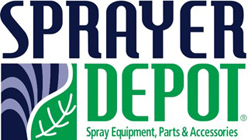Contributed by Guest Blogger:
Mark Techler, Factory Representative - Hypro & SHURflo Ag and Industrial Pumps and Accessories
Diaphragm pumps are recommended for sprayers needing pressures up to 700  psi, including applications like insecticide and fungicide spraying and spraying trees. If you need 100 psi or less for spraying or liquid transfer, consider a centrifugal pump, which will give you the option of higher flow plus these other features:
psi, including applications like insecticide and fungicide spraying and spraying trees. If you need 100 psi or less for spraying or liquid transfer, consider a centrifugal pump, which will give you the option of higher flow plus these other features:
- Centrifugal pumps are simple compared to diaphragm pumps. With so few moving parts, a centrifugal pump needs less maintenance and can last longer than a diaphragm pump. A centrifugal pump has no gearbox, diaphragms, check valves, sight glass, pulsation damper, gear lube, or crankcase oil.
- Centrifugal pumps do not require a relief valve. When the spray boom or gun on a centrifugal discharge is shut off, and the pump continues to run, the liquid internally bypasses without damaging the pump as long as a vent line is in the system.
- The line strainer can be plumbed into the discharge side of a centrifugal pump instead of the suction side as on a diaphragm pump. This eliminates the potential of a clogged strainer reducing flow to the pump suction port and causing cavitation. Use the Hypro 3350 series strainers that are rated at 200 psi.
- Higher pressure on a diaphragm pump requires more hp. Higher pressure on a centrifugal pump requires less hp. You will get less flow with higher pressure on a centrifugal, but that flow may be adequate for your application. Always consult the pump performance chart.
Tips for using centrifugal pumps:
- Consider both spray centrifugals (higher pressure) and transfer centrifugals (higher flow) when choosing a pump.
- Know your material options: cast iron, stainless steel, polypropylene, and (for transfer pumps) aluminum.
- Know your drive options: pedestal with belt and pulley or direct drive, hydraulic motor, gas engine, PTO drive with planetary gear, electric motor, and 12-volt clutch drive.
- If your liquid source provides a flooded suction you can use a non-self-priming centrifugal. Use a self-priming centrifugal pump when the liquid source is below the pump.
- Use inlet plumbing one pipe size greater than the suction port of the pump. You can choke down the discharge side but do not starve the suction side of the pump.
- Use a vent line kit to improve priming, remove air from the pump, and to let hot water escape from the pump when the outlet is shutoff - and let cooler water in. This is cheap insurance against a seal failure.
- Consider a Life Guard seal if you suspect a run dry condition. This silicon carbide seal is more abrasion resistant than standard carbon-ceramic seals and conducts heat away from the seal area, resulting in longer seal life. Use this with cast iron and stainless pumps only.
- Increase pressure by running at 6000 rpm. Hypro cast iron pedestal pumps can be belt driven to 75 gpm at 140 psi by running at 6000 rpm.
Centrifugal pumps are a low cost of maintenance option for spraying and transferring liquids.

.png?width=280&name=SameDayShippingGuarantee-New%20(1).png)




